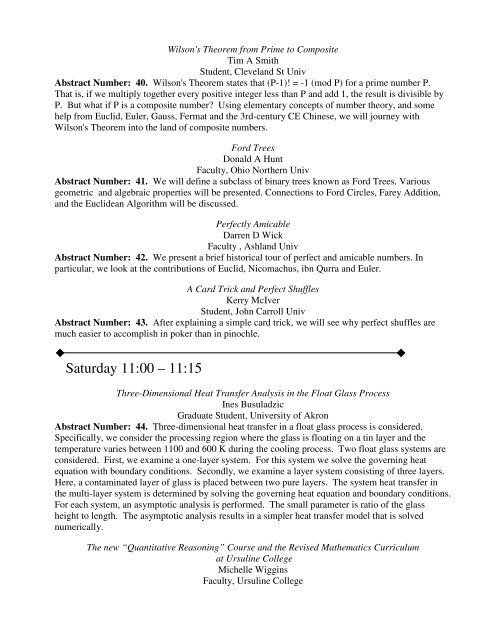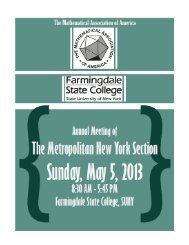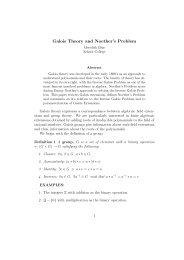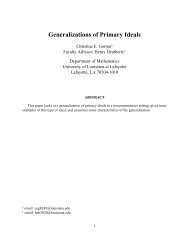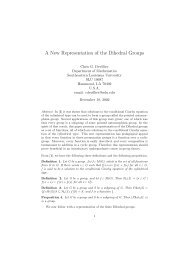Program - MAA Sections - Mathematical Association of America
Program - MAA Sections - Mathematical Association of America
Program - MAA Sections - Mathematical Association of America
You also want an ePaper? Increase the reach of your titles
YUMPU automatically turns print PDFs into web optimized ePapers that Google loves.
Wilson's Theorem from Prime to Composite<br />
Tim A Smith<br />
Student, Cleveland St Univ<br />
Abstract Number: 40. Wilson's Theorem states that (P-1)! = -1 (mod P) for a prime number P.<br />
That is, if we multiply together every positive integer less than P and add 1, the result is divisible by<br />
P. But what if P is a composite number? Using elementary concepts <strong>of</strong> number theory, and some<br />
help from Euclid, Euler, Gauss, Fermat and the 3rd-century CE Chinese, we will journey with<br />
Wilson's Theorem into the land <strong>of</strong> composite numbers.<br />
Ford Trees<br />
Donald A Hunt<br />
Faculty, Ohio Northern Univ<br />
Abstract Number: 41. We will define a subclass <strong>of</strong> binary trees known as Ford Trees. Various<br />
geometric and algebraic properties will be presented. Connections to Ford Circles, Farey Addition,<br />
and the Euclidean Algorithm will be discussed.<br />
Perfectly Amicable<br />
Darren D Wick<br />
Faculty , Ashland Univ<br />
Abstract Number: 42. We present a brief historical tour <strong>of</strong> perfect and amicable numbers. In<br />
particular, we look at the contributions <strong>of</strong> Euclid, Nicomachus, ibn Qurra and Euler.<br />
A Card Trick and Perfect Shuffles<br />
Kerry McIver<br />
Student, John Carroll Univ<br />
Abstract Number: 43. After explaining a simple card trick, we will see why perfect shuffles are<br />
much easier to accomplish in poker than in pinochle.<br />
Saturday 11:00 – 11:15<br />
Three-Dimensional Heat Transfer Analysis in the Float Glass Process<br />
Ines Busuladzic<br />
Graduate Student, University <strong>of</strong> Akron<br />
Abstract Number: 44. Three-dimensional heat transfer in a float glass process is considered.<br />
Specifically, we consider the processing region where the glass is floating on a tin layer and the<br />
temperature varies between 1100 and 600 K during the cooling process. Two float glass systems are<br />
considered. First, we examine a one-layer system. For this system we solve the governing heat<br />
equation with boundary conditions. Secondly, we examine a layer system consisting <strong>of</strong> three layers.<br />
Here, a contaminated layer <strong>of</strong> glass is placed between two pure layers. The system heat transfer in<br />
the multi-layer system is determined by solving the governing heat equation and boundary conditions.<br />
For each system, an asymptotic analysis is performed. The small parameter is ratio <strong>of</strong> the glass<br />
height to length. The asymptotic analysis results in a simpler heat transfer model that is solved<br />
numerically.<br />
The new “Quantitative Reasoning” Course and the Revised Mathematics Curriculum<br />
at Ursuline College<br />
Michelle Wiggins<br />
Faculty, Ursuline College


